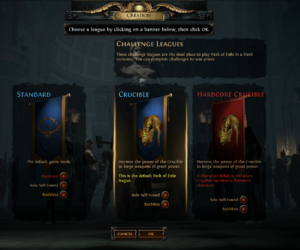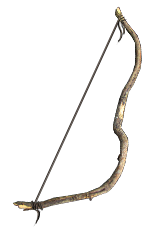User:Bloonpauper/New Player Guide
This is a guide on the subject of introducing new players to Path of Exile.
Last updated on WIP.
This is a guide for new players to Path of Exile. No previous experience in any game is required. This guide is intended to be read alongside playing the game - its contents are listed in chronological order of appearance. However, it is not a walkthrough. For those seeking an exact guide, finding a reliable content creators on youtube and following their guides is recommended. Any questions not answered by this guide are best asked on the official Discord server.
Introduction
If you are a new player to Path of Exile and play with no assistance whatsoever, likelihoods are that you are going to have a bad time. Please be aware that this is directly due to the game's complexity or difficulty - while it does have both, the real problem is that the base game does a poor job of communicating its many mechanics.
When confronted with this informational barrier, many new players turn to a guide. Specifically, guides that tell you exactly what to do in every aspect of the game - what items to equip, what passive skills to allocate, what skills to use, etc. This approach is not necessarily bad - it may work very well for many players. However, such guides rarely give new players the space and autonomy to figure things out for themselves and make their own choices, which, to the opinion of this writer is the most important aspect of the game.
The purpose of this guide is to bridge that gap - it will provide you will with all the information needed to play, enjoy, and most importantly understand the game, but it will not tell you what to do.
League selection

The first choice for any new player is to choose their league. A league is effectively the world within the character operates - it is impossible to interact with players or items inbetween leagues, unless it is the character itself that is changing leagues.
It is recommended for first-time players to choose the current challenge league (Crucible at time of writing) and to not select the Solo Self-Found, Hardcore, or Ruthless optional gamemodes.
- Solo Self-Found (known as "SSF"): Players in an SSF league cannot join parties with other players or trade with them. Due to the presence of trading in the game's balance, SSF is significantly harder than trade leagues, especially for inexperienced players.
- Hardcore (known as "HC"): Players in an HC league will be migrated to their respective SC (Softcore) league on death.
- Ruthless: All item drops are far scarcer, many items and passive skills are significantly weaker, and many mechanics are not available. Significantly harder than non-Ruthless. For those overwhelmed by the complexity of the base game, playing in Ruthless may be advisable. Choose at your own discretion.

There are two types of leagues: permanent leagues, and challenge leagues. Standard League is the main permanent league; as the term "permanent" suggests, it has been running since the release of the game and will continue indefinitely. As a result of running for so long, it is plagued with vast wealth accumulation, balance issues and a stale economy.
Challenge leagues are introduced every 3-4 months. For those who exclusive play challenge leagues (the vast majority of the player base), they represent a total reset - everyone starts off with the same footing. Along with new unique items, monsters, areas, and balance changes, challenge leagues also introduce a "League Mechanic" exclusive to the league and not available in Standard. At the end of a challenge league's duration, all its characters and items will be moved to Standard.
Class selection
Unless you are following a specific guide, there is no wrong class to choose. Path of Exile offers an unrivalled level of character customization. As a result, there are very few class-specific skills, no class-specific items, and no class-specific playstyles. Any class can do whatever they want. It is recommended to choose whatever class you want - there is no wrong choice.
The Twilight Strand
The Twilight Strand is the very first area in the game. Much of this is covered by the in-game tutorial. However, it introduces several complicated mechanics that may need further explanation.
First, pick up the weapon on the ground next to you. Each class will encounter a different weapon.
Weapon base type
Maruader receives the ![]() Driftwood ClubDriftwood ClubOne Handed Mace
Driftwood ClubDriftwood ClubOne Handed Mace
Physical Damage: 6-8
Critical Strike Chance: 5.00%
Attacks per Second: 1.45
Weapon Range: 1.1 metres10% reduced Enemy Stun Threshold![]() . It is being used here as an example to explain the individual stats of weapon base types.
. It is being used here as an example to explain the individual stats of weapon base types.

- The Duelist, Shadow, and Templar's
 Rusted SwordRusted SwordOne Handed Sword
Rusted SwordRusted SwordOne Handed Sword
Physical Damage: 4-9
Critical Strike Chance: 5.00%
Attacks per Second: 1.55
Weapon Range: 1.1 metres40% increased Global Accuracy Rating ,
,  Glass ShankGlass ShankDagger
Glass ShankGlass ShankDagger
Physical Damage: 6-10
Critical Strike Chance: 6.00%
Attacks per Second: 1.50
Weapon Range: 1.0 metres30% increased Global Critical Strike Chance , and
, and  Driftwood SceptreDriftwood SceptreSceptre
Driftwood SceptreDriftwood SceptreSceptre
Physical Damage: 8-11
Critical Strike Chance: 6.00%
Attacks per Second: 1.20
Weapon Range: 1.1 metres10% increased Elemental Damage respectively are melee weapons. As such, their stats are mechanically identical to how they are presented here and can be compared as a one-to-one analogue.
respectively are melee weapons. As such, their stats are mechanically identical to how they are presented here and can be compared as a one-to-one analogue.
- However, the
 Driftwood WandDriftwood WandWand
Driftwood WandDriftwood WandWand
Physical Damage: 5-9
Critical Strike Chance: 7.00%
Attacks per Second: 1.40(8-12)% increased Spell Damage and
and  Crude BowCrude BowBow
Crude BowCrude BowBow
Physical Damage: 5-13
Critical Strike Chance: 5.00%
Attacks per Second: 1.40 are different - they are projectile-based weapons, not melee. Instead of their "Weapon Range" value applying to melee strike attacks, their weapon range values define the base maximum distance (in units) that projectiles fired from them can travel before disappearing.
are different - they are projectile-based weapons, not melee. Instead of their "Weapon Range" value applying to melee strike attacks, their weapon range values define the base maximum distance (in units) that projectiles fired from them can travel before disappearing.
 Driftwood WandDriftwood WandWand
Driftwood WandDriftwood WandWand
Physical Damage: 5-9
Critical Strike Chance: 7.00%
Attacks per Second: 1.40(8-12)% increased Spell Damage (and to an extent,
(and to an extent,  Driftwood SceptreDriftwood SceptreSceptre
Driftwood SceptreDriftwood SceptreSceptre
Physical Damage: 8-11
Critical Strike Chance: 6.00%
Attacks per Second: 1.20
Weapon Range: 1.1 metres10% increased Elemental Damage ) are not only attack weapons - they are also spellcaster weapons. (
) are not only attack weapons - they are also spellcaster weapons. ( FireballFireballProjectile, Spell, AoE, Fire
FireballFireballProjectile, Spell, AoE, Fire
Level: (1-20)
Cost: (6-25) Mana
Cast Time: 0.75 sec
Critical Strike Chance: 6.00%
Effectiveness of Added Damage: 370%
Projectile Speed: 1040
AoE Radius: 9Unleashes a ball of fire towards a target which explodes, damaging nearby foes.Deals (9-1640) to (14-2460) Fire Damage
25% chance to Ignite enemies
Base radius is (0.9-1.4) metres
Additional Effects From 1-20% Quality:
Base radius is (0.01-0.2) metresPlace into an item socket of the right colour to gain this skill. Right click to remove from a socket.
 is a spell.) If you read their stats closely, you may find that the only stat on either item that actually affects spells is the implicit stat! Physical Damage, Critical Strike Chance, Attacks per Second, and Weapon Range are completely irrelevant to spellcasters, as they only affect attacks.
is a spell.) If you read their stats closely, you may find that the only stat on either item that actually affects spells is the implicit stat! Physical Damage, Critical Strike Chance, Attacks per Second, and Weapon Range are completely irrelevant to spellcasters, as they only affect attacks.